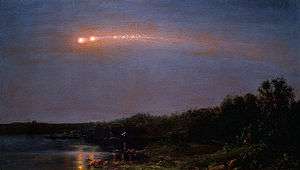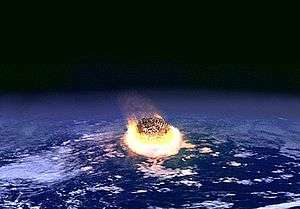Earth-grazing fireball

An Earth-grazing fireball (or Earth-grazer)[2] is a fireball, a very bright meteor that enters Earth’s atmosphere and leaves again. Some fragments may impact Earth as meteorites, if the meteor starts to break up or explodes in mid-air. These phenomena are then called Earth-grazing meteor processions and bolides.[1] Famous examples of Earth-grazers are the 1972 Great Daylight Fireball and the Meteor Procession of July 20, 1860.[1][3][4]
Overview
As an Earth-grazer passes through the atmosphere its mass and velocity are changed, so that its orbit, as it re-enters space, will be different from its orbit as it encountered Earth's atmosphere.[5][6][7]
There is no agreed-upon end to the upper atmosphere, but rather incrementally thinner air from the stratosphere (~50 km), mesosphere (~85 km), and thermosphere (~690 km) up to the exosphere (~10,000) (see also thermopause). For example, a meteoroid can become a meteor at an altitude of 85–120 km above the Earth.
Known Earth-grazing fireballs
.jpg)
An Earth-grazing fireball is a rarely measured kind of fireball[8] caused by a meteoroid that collides with the Earth but survives the collision by passing through, and exiting, the atmosphere. As of 2008 four grazers have been scientifically observed.[9]
- Meteor procession of July 20, 1860[1][3][4]
- Meteor procession of February 9, 1913 led to conclusions a temporary satellite capture of Earth had broken up[10]
- 1972 Great Daylight Fireball, August 10, 1972, US19720810 at 15 km/s above United States and Canada (first scientific observation).
- October 13, 1990, a 40 kilogram, 41.5 km/s meteoroid passed at 97.9 km above Czechoslovakia (first orbit calculation based on photographic records from two distant places).[7]
- March 29, 2006, fireball passed 18.8 km/s through the atmosphere 71.4 km above Japan[11][12]
- August 7, 2007, EN070807 passed through the atmosphere over Europe with an orbit belonging to the rare Aten asteroid type[8][13]
- June 10, 2012, an Earth-grazing fireball from the Daytime ζ-Perseid shower passed over Spain, travelling 510 km in the atmosphere. It was the faintest Earth-grazing meteor reported in the scientific literature and the first one belonging to a meteor shower.[14]
- December 24, 2014, a slow moving Christmas Eve fireball SPMN241214 passed over north Africa, Spain and Portugal, travelling about 1,200 km in the atmosphere.[15]
See also
References
- 1 2 3 4 "Texas State astronomers solve Walt Whitman meteor mystery : University News Service : Texas State University". Retrieved 2013-10-19.. Txstate.edu (2010-05-28). Retrieved on 2013-10-19.
- ↑ Nemiroff, R.; Bonnell, J., eds. (2 March 2009). "Earthgrazer: The Great Daylight Fireball of 1972". Astronomy Picture of the Day. NASA. Retrieved 2013-10-19.
- 1 2 Images of Harper's Weekly front page story
- 1 2 150-year-old meteor mystery solved
- ↑ US19720810 (Daylight Earth grazer) Global Superbolic Network Archive, 2000, 'Size: 5 to 10 m'
- ↑ Daylight Fireball of August 10, 1972 C. Kronberg, Munich Astro Archive, archived summary by Gary W. Kronk of early analysis and of Zdeněk Ceplecha's paper for Astronomy and Astrophysics in 1994, '3 meters, if a carbonaceous chondrite, or as large as 14 meters, if composed of cometary materials', 'post-encounter ... 2 or 10 meters'
- 1 2 Spurný, P.; Ceplecha, Z.; Borovicka, J. Earth-grazing fireball: Czechoslovakia, Poland, October 13, 1990, 03h27m16sUT. WGN, Vol. 19, Nr. 1, p. 13; (aphelion of its orbit changed from 2.80 AU to 1.80 AU)
- 1 2 Spurný, P. Spurný; J. Borovička; Z. Ceplecha; L. Shrbený (2008). "Precise Multi-instrument Data on 45 Fireballs Recorded over Central Europe in the Period 2006-2008" (PDF). Asteroids, Comets, Meteors. Czech Republic: Astronomical Institute of the Academy of Sciences, Fričova 298, CZ-251 65 Ondřejov Observatory. Retrieved 2008-07-06.
EN070807 fireball ... very rare Earth-grazing fireball ... Aten type
- ↑ Although other grazers have been seen and, rarely, photographed, without specialised scientific observations their orbits cannot be determined. An example is the Leonid grazer over Hawaii on 2001-11-18 -Abe 2006 (PDF)
- ↑ O'Keefe, John A. 1959. A Probable Natural Satellite: The Meteor procession of February 9, 1913. Journal of the Royal Astronomical Society of Canada, Vol. 53, p.59. Code 1959JRASC..53...59O. Retrieved 2008-07-07
- ↑ Abe 2006 (abstract)
- ↑ Abe 2006 (PDF) approximately 100 kg, orbit aphelion reaches Jupiter
- ↑ EN indicates the European Fireball Network
- ↑ Madiedo, José M.; Espartero, Francisco; Castro-Tirado, Alberto J.; Pastor, Sensi; de los Reyes, José A. "An Earth-grazing fireball from the Daytime ζ-Perseid shower observed over Spain on 2012 June 10" (PDF). Monthly Notices of the Royal Astronomical Society. 460 (1): 917–922. arXiv:1604.08380
 . Bibcode:2016MNRAS.460..917M. doi:10.1093/mnras/stw1020.
. Bibcode:2016MNRAS.460..917M. doi:10.1093/mnras/stw1020. - ↑ Moreno, A.; Madiedo, J. M.; J., Zamorano; et al. (March 2016). "Preliminary Spectroscopic and Dynamical Analysis of an Earth-Grazer Fireball Observed on December 24, 2014" (PDF). 47th Lunar and Planetary Science Conference, held March 21-25, 2016 at The Woodlands, Texas. p. 1088. Bibcode:2016LPI....47.1088M.
External links
| Look up Earth-grazing in Wiktionary, the free dictionary. |
- Fireball of 1860 (painting)
- Fireball of 1972 (photo)
